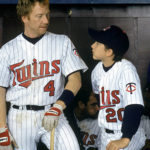Do the OPS+ Hip-Hop—It’s All the Rage in MLB
 The other night, New York Mets announcers Gary Cohen and Ron Darling discussed the inclusion of the batting average number on the television screen in front of every hitter who steps into the batter’s box … without knowing they were really talking about the OPS+ hip-hop.
The other night, New York Mets announcers Gary Cohen and Ron Darling discussed the inclusion of the batting average number on the television screen in front of every hitter who steps into the batter’s box … without knowing they were really talking about the OPS+ hip-hop.
Light-hitting Joe Panik was at the plate as they spoke.
Cohen and Darling questioned the value of showing a player’s batting average. What exactly does it mean in today’s statistic-rich environment? Should batting average still matter? If only they knew they were words away from the OPS+ hip-hop.
They agreed that seeing a batting averages on the screen under a player’s name is a baseball tradition. Even if the numbers no longer indicate a player’s true value. Sabermetrics was barely mentioned, so the OPS+ hip-hop wafted past, unrealized.
But as the discussion finished, both men agreed that, even if batting averages mean less in today’s game, fans still expect to see common references on the screen that signify Americana to them. They agreed baseball traditions die hard.
Batting average is one of those timeless values that means “play ball.” And in a world where we no longer seem to want to play ball together, batting average still means a lot. Until the appetite of the crowd settles into a new rhythm.
The OPS+ hip-hop.
What About the Joe Paniks of the Baseball World?
That’s what the San Francisco Giants said to every baseball team when they released Joe Panik in August. Please, take Joe. We’ll pay the rest of the $3.8 million we owe him, just take him. Now.
Any body is better than his.
So, the Mets took him.
After all, it cost nothing to take Panik, other than a pro-rated major league minimum salary for the last six weeks of the season. Even the Wilpon’s can afford that (bless their generous hearts).
While they did not say it, the Giants released Panik because he is the classic good defender/anemic hitter. And anemic may not be enough of an indictment of his pint-sized offensive skills.
As of September 6, Panik was hitting .243 in 423 at-bats. That’s a weak .243 that translates into an OPS+ of 72 which is below average production. Panik’s 2019 WAR is also a dreadful -0.4.
Panik should be viewed as a 28 percent below league average (level of 100) performer. His OPS+ howls that plainly.
Gary Cohen commented that there had been 76 games and 254 at bats this season between Panik’s third home run with the Giants and his fourth home run with the Mets. That’s a lot of at-bats.
In a home run crazy world, where some infielders are clubbing 20 or 30 home runs, that sets Panik apart. Just like in the everyday world, employers are demanding more productivity from their workers. They equate productivity in our meritocracy as the foundation of success.
Baseball employers are the same. They want meat on the bone.
And the Better Players?
The really good teams, like the Yankees and Dodgers, scribble in formidable offensive players everywhere on their lineup cards.
In the middle of the diamond they field players like D.J. LeMahieu, Gleyber Torres, Max Muncy and Corey Seager. All of them middle infielders who, except for Seager, play multiple positions, sport not only solid batting averages but outstanding OPS+ and WAR metrics. In short, players who help their teams win games.
While LeMahieu is hitting .331, Torres is at .283, Muncy at .253 and Seager is hitting .266, it’s clear their batting averages do not tell the whole story.
Worse, retaining batting average as the first statistic on the bottom left side of the television monitor is misleading at best, and fails to signify how teams really evaluate players.
Team’s understand the OPS+ hip-hop.
Yet fans continue to want to see batting averages when they their favorites step into the batter’s box. Because MLB.TV has yet to appreciate the nuances of the OPS+ hip-hop.
Granted, a player’s batting average may still be a timeless value. It may still scream “play ball.” But in a world of digital values, a world that spins faster and faster every day, wouldn’t it be better to know one overarching metric that tells all? That’s the OPS+ hip-hop.
Here’s the Good, the Bad, and the Ugly of OPS+
Mike Trout’s all-world OPS+ is 183.
Cody Bellinger’s OPS+ is 174.
George Springer’s OPS+ is 149.
D.J. LeMahieu’s OPS+ is 139.
Max Muncy’s OPS+ is 135
Aaron Judge’s OPS+ is 134
Gleyber Torres’ OPS+ is 131.
Whit Merrifield’s OPS+ is 116.
Corey Seager’s OPS+ is 106.
Albert Pujols’ OPS+ is 100.
______________________
Starlin Castro’s OPS+ is 87.
Dee Gordon’s OPS+ is 82
Raimel Taipia’s OPS+ is 78.
Joe Panik’s OPS+ is 72.
Rougned Odor’s OPS+ is 69.
Orlando Arcia’s OPS+ is 63.
Chris Davis’ rock bottom OPS+ is 54.
That’s Why it’s time to … Hip-Hop
Show some Sabermetric statistics under a player’s performance bar when he steps to home plate.
Time to show fans how a player is truly performing that season. Perhaps such numbers would also explain why teams employ players in key positions with what seems to be mediocre batting averages because their underlying statistics are so productive.
Knowledgeable fans more than likely understand this. But many casual fans have no idea what all these numbers mean. It might behoove baseball to educate its fans about why Mike Trout and Cody Bellinger are such outstanding players and Robinson Cano and Albert Pujols, both of whom were once outstanding players, have become albatrosses.
Consider the Seasons of Dee Gordon and Whit Merrifield
Dee Gordon has been playing on a five-year $50 million contract that ends after the 2020 season, with a 2021 option before free agency kicks in after 2021. His OPS+ this season is 82. Combine that with his 0.3 WAR this season and it begs the question, why pay $10 million for such lackluster production?
So, when you see Dee Gordon’s .280 average, remember he’s scored only 37 runs this season in 373 plate appearances. Meaning he’s not on-base enough (.305 OBP) to help his team win consistently.
In contrast, Whit Merrifield, who leads the AL with 183 hits, has a 3.2 WAR this season combined with a 116 OPS+ to go along with his .307 batting average (8th in the AL). Solid numbers. Add to that he has scored 93 runs in 642 plate appearances, (good for 11th in the AL).
Meaning Merrifield’s .306 average is rock solid and consistent with above-average performance. He is a winning player, which explains why so many teams would like to liberate him from Kansas City. Not to mention his $4 million yearly salary (a four-year $16.25 million contract with a 2023 option before he hits free agency after the 2023 season), which makes him affordable for parsimonious teams like the Mets that are reluctant to sign expensive free agents.
So, Merrifield is one of the more cost effective players in the major leagues. Plus, he plays second base and the outfield.
That teams still highly value him even though he will be entering his age-31 season in 2020, shows just how productive he has been.
So, What Is the OPS+ Hip-Hop?
It’s one number at the bottom of the screen when a player enters the batter’s box. Perhaps it’s colorized or animated or a part of a CGI that expresses a personal legend through a number and words. Or perhaps it’s combined with WAR. Not that fans cannot tell good players from bad, but there are degrees of good and good.
That’s why batting average does not matter. Pete Alonso’s .267 average is only 20 points better than Panik’s. But Alonso’s 151 OPS+ is more than twice Panik’s. That’s a difference of 78 percent. Alonso is 51 percent better than the average player, and Panik is 27 percent below-average.
That’s why OPS+ matters.
So, showing a player’s OPS+ is a more effective display of the kind of season a that player is having in one two/three-digit number. A number that ranks a player’s performance among other players. That’s players on his team, in his league, in all of MLB, or even historically.
So, that’s how these numbers encapsulate an entire world of values into a simple expression. An expression baseball could trumpet in new and effective ways. A metric that could sound like beautiful music to a whole legion of young fans hip to the latest cultural shorthand.
Maybe set OPS+ to hip-hop, the way the NFL markets their product. In a super competitive world, where winning means so much, maybe baseball needs better tools to explain to its fans why Joe Panik is not a winning player. OPS+ illustrates the idea effectively. Set to hip-hop, it might even be a more mesmerizing statistic.
























